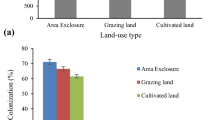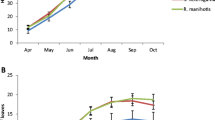Abstract
The ability of 23 year old volcanic soils from Mount St. Helens, USA, to nodulate actinorhizal Sitka alder (Alnus viridis ssp. sinuata) was studied by estimating Frankia Inoculation Unit density (FIU) in four types of primary successional communities using a host-plant bioassay. Rhizospheric Mycelial Inoculation Unit (MIU) density and the effects of inoculation with alder soil and phosphorus (P) on seedling growth were also examined. FIU and MIU were highest in alder thickets, lower in lupin patch and riparian zone sites, and lowest, with no FIUs, in bare areas. Seedling dry mass was higher in treatments inoculated with alder soil but not with P addition, while root:shoot mass ratios decreased with both inoculation and P. The extremely low densities of suitable symbionts in sparsely vegetated primary successional areas at Mount St. Helens may explain the surprisingly slow rate of spread of alder from nearby seed sources.


Similar content being viewed by others
References
Allen MF (1991) The ecology of mycorrhizae. Cambridge University Press, New York
Allen MF, Crisafulli CM, Morris SJ et al (2005) Mycorrhizae and Mount St. Helens: Story of a Symbiosis. In: Dale VH, Swanson FJ, Crisafulli CM (eds) Ecological Responses to the 1980 Eruption of Mount St Helens. Springer, New York
Arnone JA, Gordon JC (1990) Effect of nodulation, nitrogen fixation, and CO2 enrichment on the physiology, growth, and dry mass allocation of seedlings of Alnus rubra Bong. New Phytol 116:55–66 doi:10.1111/j.1469-8137.1990.tb00510.x
Baar J, van Groenendael JM, Roelofs JGM (2000) Are ectomycorrhizal fungi associated with Alnus of importance for forest development in wet environment? Plant Biol 2:505–511 doi:10.1055/s-2000-7468
Binkley D, Sollins P, Bell R et al (1992) Biogeochemistry of adjacent conifer and alder-conifer stands. Ecology 73:2022–2033 doi:10.2307/1941452
Bishop JG, Fagan WF, Schade JD et al (2005) Causes and consequences of herbivory on prairie lupine (Lupinus lepidus) in early primary succession. In: Dale VH, Swanson F, & Crisafulli CM (ed) Ecological Responses to the 1980 Eruptions of Mount St Helens. Springer Verlag, pp 151–161
Bormann BT, Gordon JC (1984) Stand density effects in young red alder plantations: productivity, photosynthate partitioning, and nitrogen fixation. Ecology 65:394–402 doi:10.2307/1941402
Bormann BT, Spaltenstein H, McClellan MH et al (1995) Rapid soil development after windthrow disturbance in pristine forests. J Ecol 83:747–757 doi:10.2307/2261411
Burleigh SH, Dawson JO (1994) Occurrence of Myrica-nodulating Frankia in Hawaiian volcanic soils. Plant Soil 164:283–289 doi:10.1007/BF00010080
Chaia EE, Fontenla SB, Vobis G et al (2006) Infectivity of soilborne Frankia and mycorrhizae in Discaria trinervis along a vegetation gradient in Patagonian soil. J Basic Microbiol 46:263–274 doi:10.1002/jobm.200510095
Chapin DM, Bliss LC, Bledsoe LJ (1991) Environmental regulation of dinitrogen fixation in a high arctic lowland ecosystem. Can J Bot 69:2744–2755 doi:10.1139/b91-345
Chapin FS, Walker LR, Fastie CL et al (1994) Mechanisms of primary succession following deglaciation at Glacier Bay, Alaska. Ecol Monogr 64:149–173 doi:10.2307/2937039
Dale VJ, Campbell DR, Adams WA et al (2005) Plant succession on the Mount St. Helens debris-avalanche deposit. In: Dale VH, Swanson FJ, Crisafulli CM (ed) Ecological Responses to the 1980 Eruptions of Mount St Helens. Springer-Verlag., pp 59–73
del Moral R, Rozzell L (2005) Long-term effects of Lupinus lepidus on vegetation dynamics at Mount St. Helens. Vegetatio 181:203–215 doi:10.1007/s11258-005-6627-4
Fagan WF, Bishop JG, Schade JD (2004) Spatially structured herbivory and primary succession at Mount St. Helens: a role for nutrients? Ecol Entomol 29:398–409 doi:10.1111/j.0307-6946.2004.00616.x
Fastie CL (1995) Causes and ecosystem consequences of multiple pathways of primary succession at Glacier Bay, Alaska. Ecology 76:1899–1916 doi:10.2307/1940722
Franklin JF, Dyrness CT (1973) Natural vegetation of Oregon and Washington. Oregon State University Press, Corvallis, OR
Gentili F, Huss-Danell K (2003) Local and systemic effects of phosphorus and nitrogen on nodulation and nodule function in Alnus incana. J Exp Bot 54:2757–2767 doi:10.1093/jxb/erg311
Giardina CP, Huffman S, Binkley D et al (1995) Alder increase soil phosphorus availability in a Douglas-fir plantation. Can J For Res 25:1652–1657 doi:10.1139/x95-179
Gill RA, Boie JA, Bishop JG et al (2006) Linking community and ecosystem development on Mount Saint Helens. Oecologia 148:312–324 doi:10.1007/s00442-006-0358-7
Halvorson JJ, Smith JL (2008) Carbon and nitrogen accumulation and microbial activity in Mount St. Helens pyroclastic substrates after 25 years. Plant Soil 315:211–228 doi:10.1007/s11104-008-9745-7
Helm DJ, Allen EB, Trappe JM (1999) Plant growth and ectomycorrhiza formation by transplants on deglaciated land near Exit Glacier, Alaska. Mycorrhiza 8:297–304 doi:10.1007/s005720050250
Hurley MA, Roscoe ME (1983) Automated statistical analysis of microbial enumeration by dilution series. J Appl Bacteriol 55:159–164
Huss-Danell K, Myrold DD (1993) Intrageneric variation in nodulation of Alnus: consequences for quantifying Frankia nodulation units in soil. Soil Biol Biochem 26:525–531 doi:10.1016/0038-0717(94)90238-0
Huss-Danell K, Sverrisson H, Hahlin AS et al (1999) Occurrence of Alnus-infective Frankia and Trifolium-infective Rhizobium in circumpolar soils. Arct Antarct Alp Res 31:400–406 doi:10.2307/1552588
Jeong SC, Myrold DD (2001) Population size and diversity of Frankia in soils of Ceanothus velutinus and Douglas-fir stands. Soil Biol Biochem 33:931–941 doi:10.1016/S0038-0717(00)00241-8
Koch AL (1981) Growth measurement. In: Gerhardt P, Costilow RN (eds) Manual of Methods for General Bacteriology. American Society for Microbiology, Washington, D.C., pp 182–207
Koo CD, Molina R, Miller S (1995) Effects of light and inoculation of Frankia and Alpova diplophloeus on the tripartite symbioses development in Alnus rubra Bong. seedlings. J Korean For Soc 84:306–218
Koo CD, Molina RJ, Miller SL et al (1996) Effects of nitrogen and phosphorus fertilization on ectomycorrhiza development, N-fixation, and growth of red alder seedlings. J Korean For Soc 85:96–106
Lawrence RL, Ripple WJ (1999) Calculating change curves for multitemporal satellite imagery: Mount St. Helens 1980–1995. Remote Sens Environ 67:309–319 doi:10.1016/S0034-4257(98)00092-3
Markham JH, Chanway CP (1996) Alnus rubra nodulation capacity of soil under five species from harvested forest sites in coastal British Columbia. Plant Soil 178:283–286 doi:10.1007/BF00011594
Markham JH, Chanway CP (1999) Does past contact reduce the degree of mutualism in the Alnus rubra-Frankia symbiosis? Can J Bot 77:434–441 doi:10.1139/cjb-77-3-434
Maunuksela L, Zepp K, Koivula T et al (1999) Analysis of Frankia populations in three soils devoid of actinorhizal plants. FEMS Microbiol Ecol 28:11–21 doi:10.1111/j.1574-6941.1999.tb00556.x
McCray Batzli J, Zimpfer JF, Huguet V et al (2004) Distribution and abundance of infective, soilborne Frankia and host symbionts Shepherdia, Alnus and Myrica in a sand dune ecosystem. Can J Bot 82:700–709 doi:10.1139/b04-044
Mead DJ, Preston CM (1992) Nitrogen fixation in Sitka alder by nitrogen-15 isotope dilution after eight growing seasons in a lodgepole pine site. Can J For Res 22:1192–1194
Molina R, Myrold D, Li CY (1994) Root symbioses of red alder: technological opportunities for enhanced regeneration and soil improvement. In: Hibbs DE, DeBell DS, Tarrant RF (eds) The biology and management of red alder. Oregon State University Press, Corvallis, OR, pp 23–46
Monaco PA, Ching KK, Ching T (1982) Host-endophyte effects on biomass production and nitrogen fixation in Alnus rubra actinorhizal symbiosis. Bot Gaz 142:298–303 doi:10.1086/337304
Myrold DD (1994) Frankia and the actinorhizal symbiosis. In: America, SSSo (ed) Methods of Soil Analysis, Part2 Microbiological and Biochemical Properties. Madison, WI, pp 291–328
Parker MA (2001) Mutualism as a constraint on invasion success for legumes and rhizobia. Divers Distrib 7:125–136 doi:10.1046/j.1472-4642.2001.00103.x
Parker MA, Malek W, Parker IM (2006) Growth of an invasive legume is symbiont limited in newly occupied habitats. Divers Distrib 12:563–571 doi:10.1111/j.1366-9516.2006.00255.x
Richardson DM, Allsopp N, D'Antonio CM et al (2000) Plant invasions—the role of mutualisms. Biol Rev Camb Philos Soc 75:65–93 doi:10.1017/S0006323199005435
Richardson SJ, Peltzer DA, Allen RB et al (2004) Rapid development of phosphorus limitation in temperate rainforest along the Franz Josef soil chronosequence. Oecologia 139:267–276 doi:10.1007/s00442-004-1501-y
Roy S, Khasa DP, Greer CW (2007) Combining alders, Frankia, and mycorrhizae for the revegetation and remediation of contaminated ecosystems. Can J Botany-Revue Canadienne De Botanique 85:237–251 doi:10.1139/B07-017
Sprent JI (1993) The role of nitrogen fixation in primary succession on land. In: Miles J, Walton DWH (eds) Primary Succession on Land. Blackwell Scientific, Oxford, pp 209–220
Titus JH (2008) Nitrogen-fixers Alnus and Lupinus increase soil fertility but not invasion by late successional species in primary succession on Mount St. Helens. Plant Ecol (in press)
Titus JH, Moral RD, Gamiet S (1998) The distribution of vesicular-arbuscular mycorrhizae on Mount St. Helens. Madrono 45:162–170
Titus JH, Whitcomb S, Pitoniak HJ (2007) Distribution of arbuscular mycorrhizae in relation to microsites on primary successional substrates on Mount St. Helens. Can J Bot 85:941–948 doi:10.1139/B07-099
Uliassi DD, Ruess RW (2002) Limitations to symbiotic nitrogen fixation in primary succession on the Tanana River floodplain. Ecology 83:88–103
Uliassi DD, Huss-Danell K, Ruess RW et al (2000) Biomass allocation and nitrogenase activity in Alnus tenuifolia: responses to successional soil type and phosphorus availability. Ecoscience 7:73–79
Vance CP (2001) Symbiotic nitrogen fixation and phosphorus acquisition. Plant nutrition in a world of declining renewable resources. Plant Physiol 127:390–397 doi:10.1104/pp.010331
Vitousek PM (1999) Nutrient limitation to nitrogen fixation in young volcanic sites. Ecosystems (N Y, Print) 2:505–510 doi:10.1007/s100219900098
Walker LR (1993) Nitrogen fixers and species replacements in primary succession. In: Miles J, Walton DWH (eds) Primary succession on land. Blackwell Scientific, Oxford, pp 249–272
Walker LR, Chapin FS III (1986) Physiological controls over seedling growth in primary succession on an Alaskan floodplain. Ecology 67:1508–1523 doi:10.2307/1939082
Wolters DJ, van Dijk C, Akkermans ADL et al (1999) Ineffective Frankia and host resistance in natural populations of Alnus glutinosa (L.). Gaertn. Acta Oecol 20:71–79 doi:10.1016/S1146-609X(99)80018-6
Zar JH (1999) Biostatistical analysis. Prentice-Hall, Englewood Cliffs, NJ
Acknowledgements
The authors thank friends, family, and colleagues who supported this work, especially Douglas and Barbara Seeds, Sally Hacker, Jonathan Titus, and David Myrold. The manuscript was greatly improved by advice of four anonymous reviewers. This work was supported by grants from the Northwest Orchid Society and National Science Foundation DEB-0089843.
Author information
Authors and Affiliations
Corresponding author
Additional information
Responsible Editor: Juha Mikola.
Rights and permissions
About this article
Cite this article
Seeds, J.D., Bishop, J.G. Low Frankia inoculation potentials in primary successional sites at Mount St. Helens, Washington, USA. Plant Soil 323, 225–233 (2009). https://doi.org/10.1007/s11104-009-9930-3
Received:
Accepted:
Published:
Issue Date:
DOI: https://doi.org/10.1007/s11104-009-9930-3




